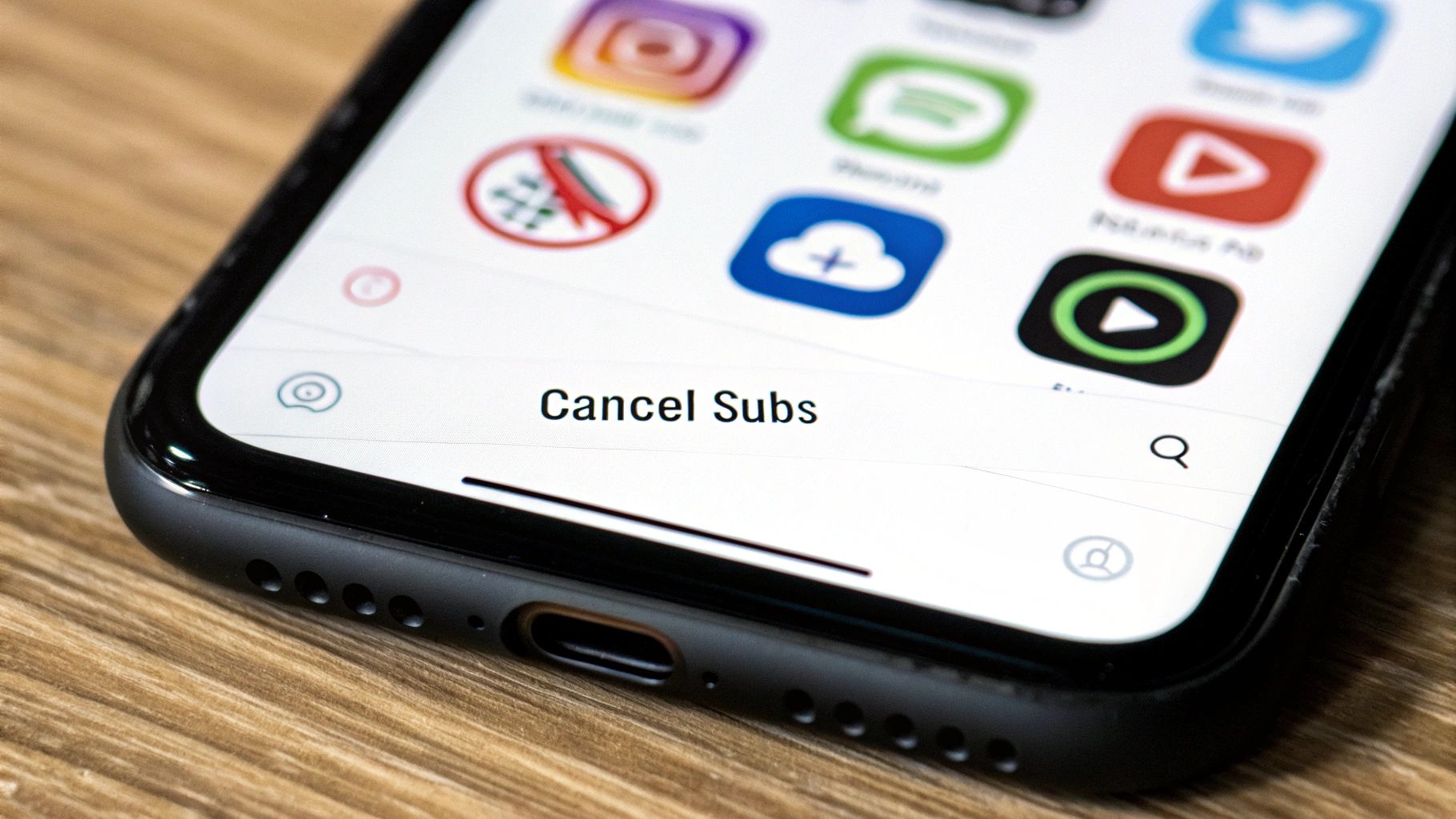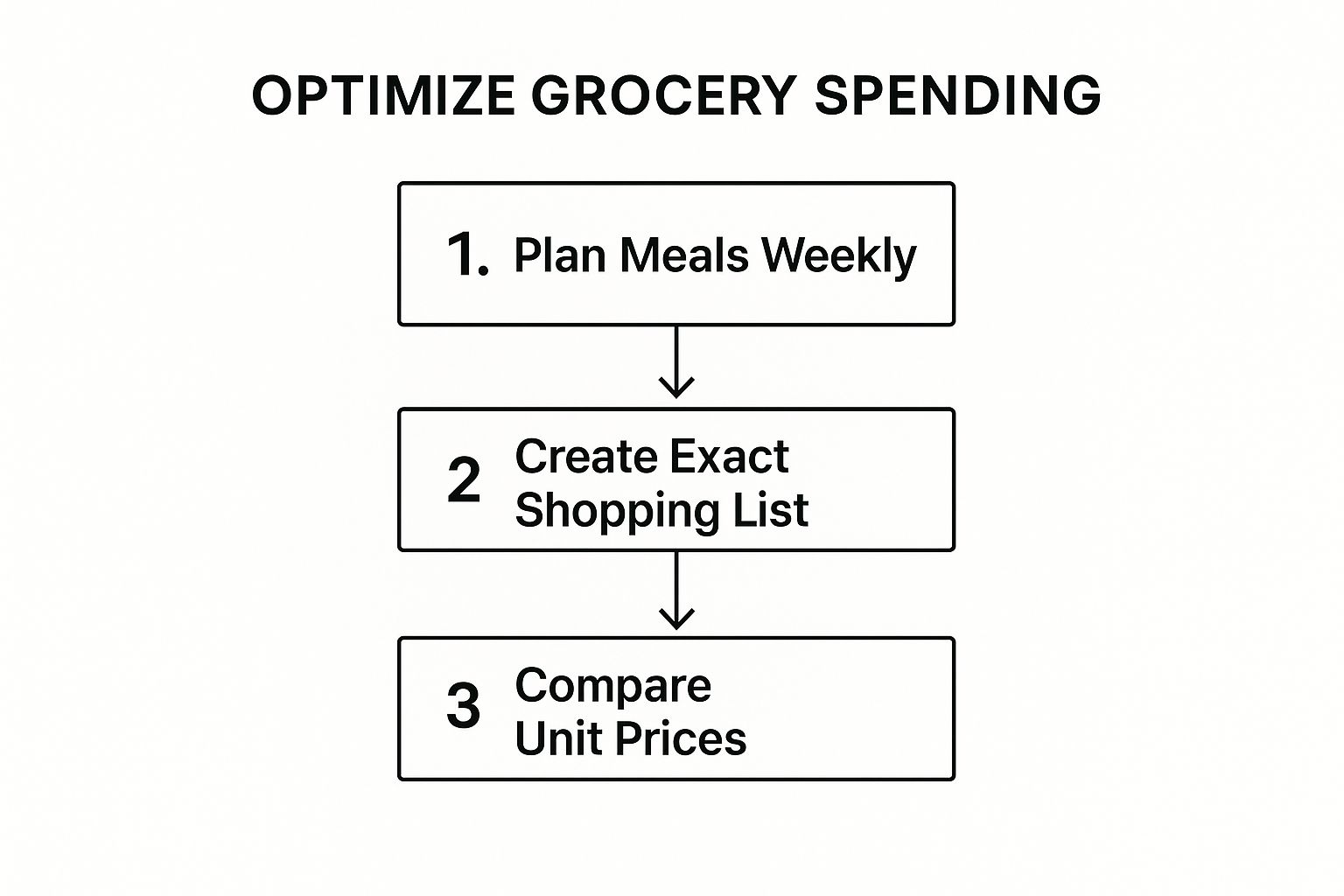
How to Reduce Monthly Bills: Top Tips to Save More
Share
Cutting your monthly bills isn't about drastic, painful sacrifices. It all starts with a much simpler, yet powerful, first step: truly understanding where your money is going. Before you can make smart cuts, you need a clear picture of your spending habits. This is where you’ll spot the easiest wins.
Finding Savings Before You Start Cutting
Let's be honest, nobody gets excited about tracking expenses. Most of us imagine being buried in complicated spreadsheets for hours on end. But you don't need to do all that. A quick, high-level analysis is usually all it takes to feel back in control. The point isn't to beat yourself up over past purchases; it’s about creating a simple, effective roadmap for future savings.
A great way to start is by splitting your expenses into two basic buckets: fixed and variable costs.
- Fixed Costs: These are the bills that are pretty much the same every single month. Think rent or mortgage, a car payment, or your insurance premiums. They’re predictable.
- Variable Costs: These are the expenses that fluctuate depending on your lifestyle and choices. This category includes things like groceries, gas for your car, nights out, and entertainment.
This simple exercise immediately shows you where you have the most power. It’s tough to lower your rent overnight, but you have a lot more control over your variable spending.
Once you’ve done that, you can add another layer: needs versus wants. A need is something essential for survival, like housing, basic food, and utilities. A want is something you enjoy but could technically live without—think streaming subscriptions, that daily coffee, or tickets to a show.
Key Takeaway: The sweet spot for quick and meaningful savings is almost always at the intersection of variable costs and wants. This is your financial low-hanging fruit.
For example, maybe you realize that daily coffee from the local cafe is setting you back $100 a month, or a forgotten streaming service you rarely use is quietly taking another $15. These small, recurring "wants" add up fast, and that’s money that could be working for you elsewhere.
You wouldn't be alone in this approach. A recent survey found that around 30% of Americans are actively trimming discretionary spending on things like dining out and shopping to get a better handle on their finances. You can read more about this consumer trend in the full S&P Global report.
To help you get started, here's a quick way to look at your own bills.
Quick Guide for Analyzing Your Monthly Bills
Use this table to quickly categorize common expenses and identify which bills have the most potential for savings.
| Expense Category | Type (Fixed/Variable) | Control Level (High/Low) | Action to Consider |
|---|---|---|---|
| Rent/Mortgage | Fixed | Low | Consider refinancing or a roommate long-term |
| Car Payment | Fixed | Low | Refinance or plan for a cheaper car next time |
| Groceries | Variable | High | Plan meals, use coupons, buy generic brands |
| Dining Out | Variable | High | Set a weekly limit, cook more at home |
| Streaming Services | Fixed (recurring) | High | Cancel unused services, rotate them, or share |
| Cell Phone Bill | Fixed (recurring) | High | Switch to a cheaper plan or a budget carrier |
| Utilities (Electric/Gas) | Variable | Medium | Adjust thermostat, use energy-efficient appliances |
| Gym Membership | Fixed (recurring) | High | Cancel if unused, find cheaper alternatives |
This kind of birds-eye view makes it much easier to pinpoint exactly where you can make changes without feeling deprived.
Think of this review as the foundation for building a smarter savings strategy. For a more detailed look at creating a budget that actually works, check out our guide on how to save money each month. Once you have this clarity, you're empowered to make targeted cuts that align with your real priorities, instead of just taking wild guesses at where to trim the fat.
Tackle Your Biggest Household Expenses Head-On

Now that you have a good handle on where your money is going, it’s time to zero in on the heavy hitters: housing, utilities, and groceries. For most people, these three areas eat up the biggest chunk of the monthly budget. The good news? Even small, strategic changes here can free up a surprising amount of cash. Let’s move past the obvious advice and get into specific actions you can take.
Housing is almost always the biggest expense, but that doesn't mean it's completely fixed. If you're a renter, don't just automatically accept the renewal rate. Do a little homework. See what comparable places in your neighborhood are going for. If you’ve been a great tenant and the market has cooled, you've got solid ground to stand on for a friendly negotiation.
For homeowners, refinancing your mortgage might be a smart move. It’s not a magic bullet and really depends on whether current interest rates are significantly lower than what you’re paying now. The whole point is to lock in a new, lower rate that cuts down your monthly payment.
A good rule of thumb is to look into refinancing if you can drop your interest rate by at least 0.75% to 1%. Just remember to weigh the closing costs against your monthly savings to figure out your break-even point.
Get a Handle on Your Utility Bills
Utilities can feel like a runaway train, but you have more control than you might think. A quick DIY energy audit is a great starting point. Feel for drafts around your windows and doors, make sure your attic insulation is up to par, and finally swap out those old incandescent bulbs for LEDs. These little fixes add up, preventing you from literally leaking money.
Here's another trick: call your utility providers and ask about budget billing or level payment plans. This won't lower your overall yearly cost, but it smooths out your payments into one predictable monthly bill. No more shocking heating bills in the winter or AC costs in the summer. Predictability is a budgeter's best friend. Once your major bills are stable, you can get even more granular with your savings. We've got a great guide on how to manage online subscriptions that can help you trim the fat there, too.
Shop Smarter, Not Harder, at the Grocery Store
The grocery bill is where many budgets go off the rails, but it’s also where you have the most direct control. The secret is to shop with a clear plan, not an empty stomach.
- Become a Unit Price Pro: Those big, flashy sale signs are designed to grab your attention. Instead, train your eye to look for the unit price on the shelf tag—the price per ounce, per pound, or per 100-count. It’s the only real way to know if you're getting a good deal.
- Meal Prep is Your Secret Weapon: Planning your meals for the week before you even step foot in a store is a game-changer. It gives you a laser-focused shopping list, cuts down on those tempting impulse buys, and drastically reduces food waste.
- Don't Be Afraid to Trade Down: If you find yourself reaching for store brands over the big names, you're in good company. In fact, 75% of U.S. shoppers are now "trading down" to save money. This simple swap can shave a significant amount off your total bill, often with no noticeable drop in quality.
Slicing Your Transportation and Insurance Bills

When you look at your monthly budget, transportation and insurance can feel like concrete pillars—massive, unmovable expenses. But I’ve learned they're not nearly as fixed as they seem. With a little digging and a willingness to question the status quo, you can often find some serious savings hiding in plain sight.
Take your car, for example. It’s easy to focus on the loan payment and what you spend on gas, but that’s just the tip of the iceberg. Once you add up insurance, routine maintenance, surprise repairs, and depreciation, the real cost of keeping that vehicle on the road is staggering. In fact, the average cost to own and operate a new car has climbed to over $12,000 a year. That’s about $1,000 every single month.
Seeing that number should spark a question: Is my current car really worth that much to me?
Maybe it's time to consider a change. Could you downsize to a smaller, more fuel-efficient car? Or explore carpooling or public transit for your daily commute? Even leaving the car parked just two days a week can make a dent in your fuel and maintenance costs over time.
Give Your Insurance an Annual Check-Up
Your insurance policies—for your car, home, or apartment—are another area ripe for savings. Blind loyalty to a single insurance provider rarely translates into the best deal anymore. I make it a point to shop for new quotes every single year, and it usually takes less than an hour.
Before you start calling around or using online comparison tools, have your current policy details handy. You want to be able to compare apples to apples. But don't just ask for a generic quote; get specific and ask what discounts you’re eligible for. You might be surprised by what you're missing out on.
Here are a few common ones to ask about directly:
- Bundling Discount: Insuring your home and auto with the same company can often knock 5% to 25% off your total bill. Always get a bundled quote.
- Low-Mileage Discount: If you drive less than the national average (usually under 7,500 miles per year), you should be paying less. This is a big one for anyone who works from home.
- Safe Driver Discount: A clean driving record is valuable. If you've gone years without an accident or ticket, make sure your rate reflects it.
- Good Student Discount: Have a young driver on your policy who's doing well in school? This can definitely help trim your premium.
My Favorite Pro-Tip: Don't be shy about telling a new insurance agent what you're currently paying. It gives them a clear number to beat and often encourages them to find every last discount to win your business.
The real trick is to stop thinking of these expenses as non-negotiable. By treating your car and insurance costs as flexible items in your budget, you take back control. This hands-on approach is key to making sure you aren't overpaying for two of the biggest line items in your monthly spending.
Winning the Battle Against Subscription Creep
We’ve all been there. You sign up for a free trial, and before you know it, a $9.99 charge pops up on your statement. You download a cool new app, use it once, and then forget it exists. Soon enough, a dozen of these small, seemingly harmless charges are quietly siphoning a surprising amount of cash from your account every month.
This slow financial drain has a name: subscription creep. It’s one of the easiest ways to blow your budget, but thankfully, it's also one of the simplest problems to fix.
The first move is to get a clear picture of the damage. I call this a subscription audit. Grab your bank and credit card statements from the last two months and go through them with a fine-tooth comb. Your mission is to hunt down every single recurring charge, no matter how small.
Make a list. Write down everything from the obvious ones like Netflix and Spotify to the sneaky ones like cloud storage, premium app features, or that online magazine you subscribed to just to read one article. Laying it all out in black and white is often a real wake-up call.
Get Smart with Subscription Cycling
Once you have your list, you can get strategic. This doesn't mean you have to go scorched-earth and cancel everything you enjoy. Instead, try a technique I’ve used for years called subscription cycling. It’s all about actively pausing or canceling services when you’re not using them and only turning them back on when you are.
Think about it: maybe you only fire up HBO Max when a specific series is airing. Why pay for it year-round? Just subscribe for the two months the show is on and then cancel. You can do the exact same thing for sports packages during the off-season or for an educational platform you only needed for a specific project. This way, you still get all the content you love without paying for the downtime.
This simple habit can easily save you hundreds of dollars a year, and you won't feel like you're missing out on anything. It’s about paying for what you actually use, not just for having access.
Maximize Savings with Shared Accounts
Here’s another powerful tactic to slash those monthly bills: take full advantage of family plans and shared accounts. It’s amazing how many services, from music streaming to software suites, offer multi-user plans that are way cheaper than paying for several individual subscriptions.
- Streaming Services: A Netflix Premium plan lets four people watch at once, and a Spotify Premium Family plan covers up to six people under one roof.
- Software and Tools: Many of the productivity and creative tools we use daily have family or team plans that offer huge savings.
- Group Buying Platforms: This is where it gets really interesting. Platforms like AccountShare let you legally and securely join group buys for premium tools and services. You get to split the cost with other users and lock in the best possible price.
If you want a more detailed guide on finding and cutting these hidden costs, our walkthrough on how to cancel unwanted subscriptions will help you clean up your finances for good.
The infographic below shows a simple three-step process for optimizing another major expense—groceries. The principle is the same: smart planning and conscious decision-making.

Just like planning your meals helps you sidestep impulse buys at the supermarket, auditing your subscriptions stops wasteful spending on digital services. When you actively manage these accounts, you turn a major monthly expense into a controlled part of your budget, freeing up more cash for the things that really matter to you.
Tackle Your Debt and Sneaky Bank Fees

High-interest debt and those pesky banking fees are the silent killers of a healthy budget. They work behind the scenes, siphoning off your hard-earned cash through compounding interest and small, recurring charges you might not even notice. Getting a handle on these expenses is a huge step toward reducing your monthly bills and freeing up your money.
When you're staring down a mountain of debt, especially from credit cards, it can feel like you're fighting a losing battle on multiple fronts. The secret isn't to fight harder, but to fight smarter. You need a focused, proven strategy. Two of the most popular and effective approaches are the debt snowball and the debt avalanche.
Picking the Right Debt Repayment Plan for You
The debt snowball method is all about psychology and momentum. With this approach, you list your debts from smallest to largest and throw every extra dollar you have at the smallest one first, while making minimum payments on the rest. Once that first debt is gone, you roll its payment into the next smallest one. It’s incredibly motivating to see entire debts disappear from your list.
Then there's the debt avalanche method, which is the clear winner from a purely mathematical standpoint. Here, you focus on paying off the debt with the highest interest rate first, regardless of the balance. You won't get those quick, satisfying wins like you do with the snowball, but you’ll end up paying less in interest over the long haul.
So, which one is better? Honestly, it comes down to what makes you tick.
- Go with the Snowball if: You need those early victories to keep your motivation high and build momentum.
- Opt for the Avalanche if: You’re disciplined enough to stick with it and your main goal is to save the most money possible.
Expert Tip: Just Ask for a Lower Rate. Seriously, pick up the phone and call your credit card company. Tell them you’ve been a loyal customer and are looking at other offers. The worst they can say is no, but a five-minute call could easily lower your APR and save you hundreds of dollars.
Smart Tools for Consolidating Your Debt
Sometimes, you need a specific tool to really get things moving. Balance transfer cards and personal loans are two common options, but it's crucial to understand what you're getting into.
A balance transfer card can be a game-changer. These cards offer a 0% introductory APR for a set period, often 12 to 21 months. You can move your high-interest credit card debt onto this new card and attack the principal balance without it growing. Just watch out for the transfer fee (usually 3%-5%) and have a solid plan to pay off the entire balance before that intro period ends and the rate skyrockets.
A debt consolidation loan is another route. It rolls all your different debts into one single loan, giving you a predictable fixed monthly payment. Often, the interest rate is lower than what you were paying on your credit cards. This really simplifies your financial life, but be aware that it might extend the time it takes to pay everything off.
Getting a grip on debt is more important now than ever. With personal income in the U.S. recently taking a dip and the national savings rate shrinking, many households are feeling the squeeze. In this kind of economic environment, reducing your debt isn't just a good idea—it's essential for your financial security. For a deeper dive into these economic trends, you can check out this EY report on personal income.
Got Questions About Cutting Your Bills? We’ve Got Answers.
Deciding to get a handle on your monthly expenses is a great first step, but it's natural for a few questions to pop up along the way. Honestly, knowing what to expect can be the difference between sticking with it and giving up. Let's walk through some of the most common hurdles people face when they start trying to save.
I'm Completely Overwhelmed. Where Do I Even Begin?
That feeling of being paralyzed by a long list of bills is completely normal. The best way to break through it is to go for a quick, easy win.
My advice? Tackle "subscription creep" first. Just pull up your latest bank or credit card statement and take a highlighter to every recurring charge you see—streaming services, software, apps, you name it. You'll probably be surprised. Canceling a couple of these you forgot you even had is an instant victory, and that momentum is exactly what you need to start looking at the bigger fish.
How Quickly Will I Actually See Savings?
Some changes pay off almost immediately. When you cancel that Netflix or Spotify subscription, the savings kick in on the very next billing cycle. Boom, instant cash back in your pocket.
For the bigger-ticket items, like haggling with your car insurance company or your internet provider, you’ll see the new, lower rate on your next statement.
The real magic happens with consistency. A few small tweaks here and there can easily add up to an extra $50-$100 in your account within the first month. The larger savings might take a little longer to materialize, but those are the changes that really make a dent in your budget for years to come.
How Can I Get My Family to Cooperate?
This one is critical. Getting your family on board isn’t about laying down the law; it's about making it a team sport.
Call a family meeting, but don’t start with "We need to stop spending money." Instead, frame it around a shared goal that gets everyone excited. Try something like, "What if we saved up for that awesome family trip we've been talking about? Let's brainstorm some ways we can make it happen." When everyone has a say and understands why you're making changes, they'll be your biggest allies, not your biggest obstacles.
What if I Try to Negotiate and They Just Say No?
It's going to happen. Some companies have iron-clad pricing and just won't play ball, no matter how nicely you ask. Don't take it personally or see it as a dead end.
Think of it as a signal. If your current provider isn't willing to work with you, it's the perfect time to see who else wants your business. Your loyalty is to your budget, not to a company that doesn't value you. In a competitive market, there’s almost always another provider out there ready to offer you a better deal.
Ready to unlock maximum savings on your digital subscriptions? With AccountShare, you can legally and securely split the cost of premium services with a group. Stop overpaying and start saving today. Find out how much you can save with AccountShare.
